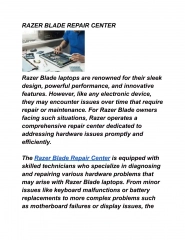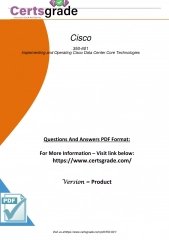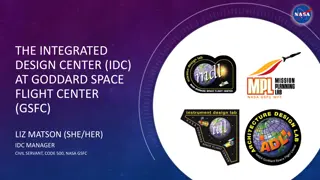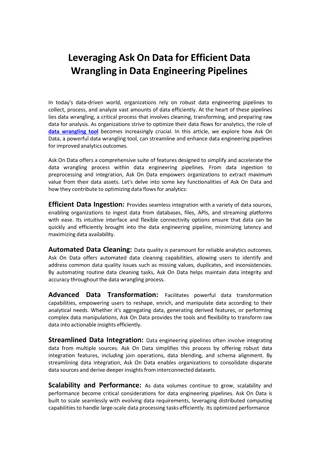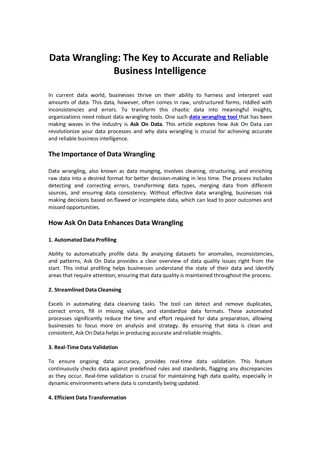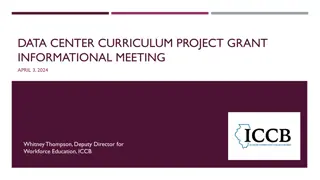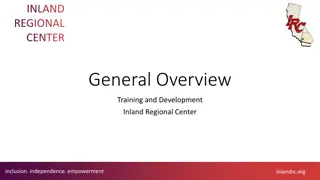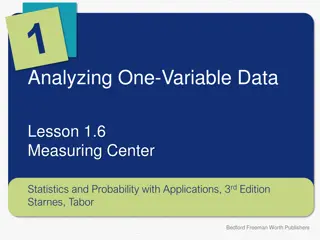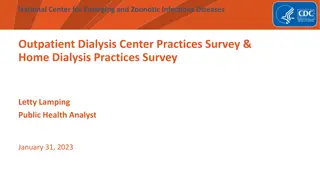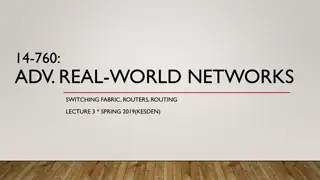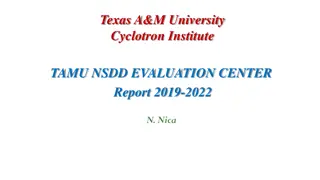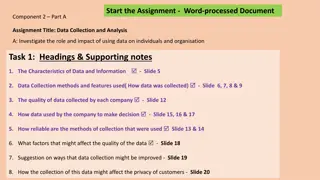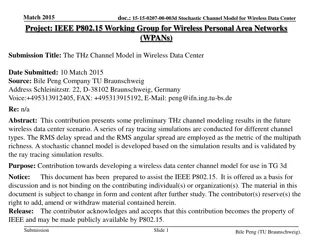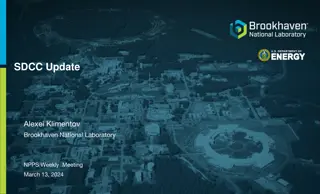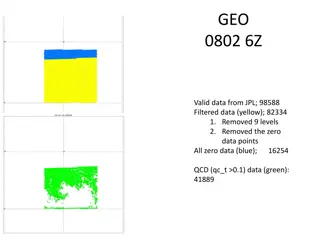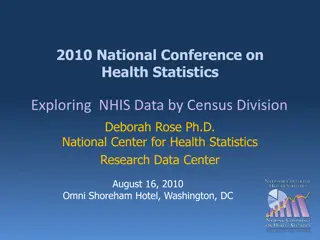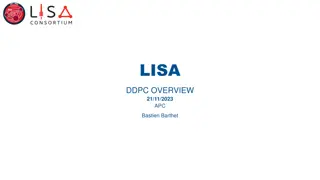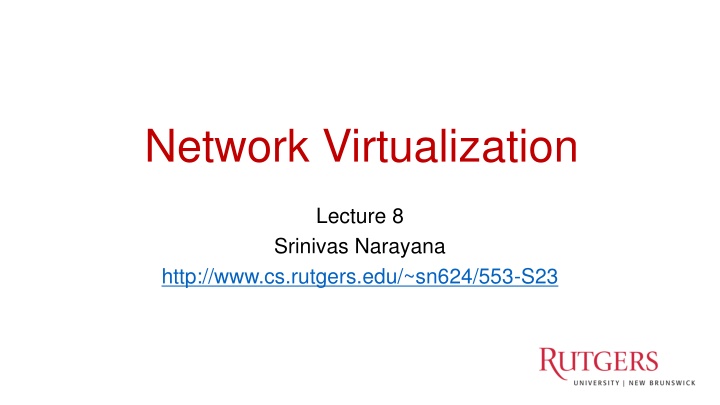
Virtualizing Networking in Shared Clusters and Multi-tenant Data Centers
Explore network virtualization concepts including typical network structures, design choices for L2 and L3 protocols, and the use of customer addresses (CAs) or provider addresses (PAs) in virtualized environments. Learn about goals and challenges in scaling, migrating, and simplifying network configurations for tenant workloads across physical machines.
Download Presentation

Please find below an Image/Link to download the presentation.
The content on the website is provided AS IS for your information and personal use only. It may not be sold, licensed, or shared on other websites without obtaining consent from the author. If you encounter any issues during the download, it is possible that the publisher has removed the file from their server.
You are allowed to download the files provided on this website for personal or commercial use, subject to the condition that they are used lawfully. All files are the property of their respective owners.
The content on the website is provided AS IS for your information and personal use only. It may not be sold, licensed, or shared on other websites without obtaining consent from the author.
E N D
Presentation Transcript
Network Virtualization Lecture 8 Srinivas Narayana http://www.cs.rutgers.edu/~sn624/553-S23 1
Virtualizing Networking in a Shared Cluster
Typical network structure: Fat Trees Spine switch Capacities must increase as you go up the tree Agg switch ToR switch Rack
Goals Terminology: tenant/customer and provider Virtual NIC (vNIC): network interface exposed with SR-IOV or network namespaces (1) Place tenant workloads on any physical machine (2) Scale or migrate tenant workload across physical machines at any time (3) Simplify configuration for everyone involved Views of tenant addresses and interfaces Tenant apps using load balancing, DNS-based IP discovery, etc. Provider s ability to plumb tenant workloads together Migration from on-premise compute cluster to shared cloud
Design Choice (1): L2 or L3? L2: zero configuration, but doesn t scale due to broadcast Support seamless migration within L2 network Broadcast storms: learning switch, ARPs Scale broadcast by isolating physical machines into VLANs. However, this requires configuring physical switch ports. Complicates migration. L3: no broadcast, but configuration needed to run routing protocols Configure both endpoints (e.g. gateways) and routers (IP prefixes) Migration is not cheap but doable with a little work e.g., with BGP, we know how to propagate reachability information changing over time in a scalable fashion
Design Choice (2): CAs or PAs? Do VMs/pods use their own customer addresses (CA s) or use the infrastructure s provider addresses (PA s)? PA s: supporting routing is business as usual But one tenant s ports affected by other tenants on same machine Need static allocation of ports to tenants, or dynamic port discovery Reduced isolation, more complex configuration, app changes CA s: dedicated IP per VM/pod, visible to applications Clean and backwards compatible. e.g. DNS If VM/pod A sees its own address to be X, any VM/pod B talking to A also thinks that A has address X. A is reachable with CA address X. However, need to design networking to route between CA s, Example: migrate VMs/pods across PA s with unchanging CA
Networking in a multi-tenant data center Address virtualization: VMs/pods use own addresses (CA s) Physical network does not know how to route CA s Additional software to translate CA s between PA s: Tunneling Tunneling endpoint (TEP): software tun/tap interface, NIC hardware, or software switch in a hypervisor. Overlay. TEP encapsulates and decapsulates packet headers (VXLAN, GRE) Topology virtualization: Tenants should be able to bring own custom network topologies or assume one big switch Facilitate migration into public cloud, consistent view for tenant s monitoring and maintenance tools, etc. Supporting virtualized service models e.g. rate limits and isolation across tenants sharing a physical machine
Example 1: Nicira Virtualization Platform NVP: Motivated by migration of on-premise cloud workloads as seamlessly as possible to cloud Address virtualization: VM s see and use CA s Topology virtualization (bring your own topology) packets processed through logical switch/router tenant topology Tables populated by classic routing protocols (e.g. OSPF, BGP) Edge: logical datapaths and TEPs (vNIC hypervisor OVS) Network core is a simple pipe that routes between TEPs
Topology and Address Virtualization Topology virtualization Effect: Move packets from source vNIC to dest vNIC Address virtualization (separation of tenant and provider addresses through tunneling) Performance: Caching
SDN in NVP: Controller design Declarative design: language to specify tuples of rules/relations No need to implement a state machine to transition rule sets Use a compiler to emit correct, up to date logical datapaths (tuples) Shared-nothing parallelism to scale Different logical datapaths easily distributed Template rules output from logical datapaths may be independently specialized to specific hypervisors and VMs Controller availability maintained using standard leader election mechanisms Control and data paths fail independently Existing OVS hypervisor rules can process packets even if controller fails Fast failover through precomputed failover installed in the data path
Example 2: Azure VFP Tenants use CA-space addresses One big switch Multiple controllers, each programming distinct layer(s) Layer implements a part of the policy: NAT, etc. The TEP itself is a MAT Stateful actions (e.g. NAT) are first-class citizens Unified flow tables (caching)
Example 3: Kubernetes/CNIs Container Network Interfaces: configuring networking for inter- pod networking Within a pod, use loopback interface (e.g. service mesh) Pods use CA-space addresses (overlay); but PA also possible (underlay) Topology virtualization: If CA, TEP configured through In-kernel forwarding (L3 forwarding tables, netfilter, iptables) Bridging Tun/tap software interface eBPF Can use either L2 or L3 networking to interconnect CAs
Example 3: Kubernetes/CNIs Example with L2+L3 overlay
Making old software use new networks usually means making new networks behave like old ones.
Making forwarding more programmable Proliferation of fixed table types

